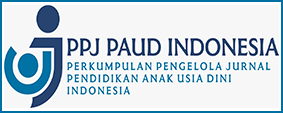
Author
Rohita Rohita(1
Pendidikan Anak Usia Dini, Universitas Negeri Jakarta, Indonesia(1)
Pendidikan Anak Usia Dini, Universitas Negeri Jakarta, Indonesia(2)
Pendidikan Anak Usia Dini, Universitas Negeri Jakarta, Indonesia(3)
| Article Analytic |
Published : 2023-11-19
Article can trace at:
 Article Metrics
Article Metrics
Abstract Views: 336 times
PDF Downloaded: 225 times
Abstract
Lebak merupakan salah satu kabupaten di provinsi Banten yang memiliki potensi sebagai sumber belajar bagi anak, khususnya untuk pengembangan kemampuan berpikir kritis. Penelitian ini bertujuan untuk menganalisis pengembangan kemampuan berpikir kritis anak melalui pengenalan budaya Lebak dalam pembelajaran. Penelitian dilakukan secara kualitatif dengan guru TK PGRI 1, Lebak, Banten sebagai subjeknya. Pengumpulan data dilakukan menggunakan metode observasi dan wawancara mendalam. Analisis data menggunakan model Miles and Hubberman. Hasil penelitian menunjukkan bahwa guru telah mengenalkan budaya Lebak yang mencakup makanan tradisional, permainan tradisional, dan pakaian tradisional kepada anak. Namun pertanyaan yang diajukan sebagai salah satu stimulasi kemampuan berpikir anak, masih berada pada kategori pertanyaan yang cenderung memunculkan kemampuan berpikir tingkat rendah (lower order thinking). Simpulannya adalah kemampuan berpikir kritis (higher order thinking) belum terstimulasi meskipun guru telah mengenalkan budaya Lebak dalam pembelajaran. Implikasinya guru harus meningkatan kemampuan bertanya yang menstimulasi kemampuan berpikir kritis anak dengan materi mengenai budaya Lebak.
Keywords
References
Anggraena, Y., Ginanto, D., Felicia, N., Andiarti, A., Herutami, I., Alhapip, L., Iswoyo, S., Hartini, Y., & Mahardika, R. L. (2022). Panduan Pembelajaran dan Asesmen. In L. Yuniarsih, M. Chatarina, N. Kadariyah, & S. Matakupan (Eds.), Badan Standar, Kurikulum, Dan Asesmen Pendidikan Kementerian Pendidikan, Kebudayaan, Riset, Dan Teknologi Republik Indonesia.
Ariyana, Y., Pudjiastuti, A., Bestary, R., & Zamroni. (2018). Buku Pegangan Pembelajaran Keterampilan Berpikir Tingkat Tinggi Berbasis Zonasi. Program Peningkatan Kompetensi Pembelajaran Berbasis Zonasi. In Buku Pegangan Pembelajaran Berorientasi Pada Keterampilan Berfikir Tingkat Tinggi. Direktorat Jenderal Guru dan Tenaga Kependidikan. Kementerian Pendidikan dan Kebudayaan. 2018. https://repositori.kemdikbud.go.id/11316/1/01._Buku_Pegangan_Pembelajaran_HOTS_2018-2.pdf
Astuti, I. A. D., Bhakti, Y. B., & Sumarni, R. A. (2021). Identifikasi Budaya Menjemur Padi “MOE” di Lebak sebagai Sumber Belajar Berbasis Etnofisika. Nucleus, 2(1), 33–38. https://doi.org/10.37010/nuc.v2i1.409
Battersby, M., & Bailin, S. (2018). Inquiry: A New Paradigm for Critical Thinking. In L. Groarke & C. Tindale (Eds.), Inquiry: A New Paradigm for Critical Thinking (Issue October 2020). https://doi.org/10.22329/wsia.07.2018
Bulent, D., Erdal, B., Ceyda, A., Betul, T., Nurgul, C., & Cevahir, D. (2016). An analysis of teachers questioning strategies. Educational Research and Reviews, 11(22), 2065–2078. https://doi.org/10.5897/err2016.3014
Choy, S. C., & Cheah, P. K. (2009). Teacher Perceptions of Critical Thinking among Students and Its Influence on Higher Education. International Journal of Research in Science and Technology, 20(2), 198–206. https://doi.org/10.37648/ijrst.v10i04.002
Cleovoulou, Y., & Beach, P. (2019). Teaching critical literacy in inquiry-based classrooms: Teachers’ understanding of practice and pedagogy in elementary schools. Teaching and Teacher Education, 83, 188–198. https://doi.org/10.1016/j.tate.2019.04.012
Dewey, J. (1910). How We Think. D. C. HEATH & CO. https://www.ptonline.com/articles/how-to-get-better-mfi-results
Dewi, A. C., Hapidin, H., & Akbar, Z. (2019). Pengaruh Model Pembelajaran dan Kemampuan Berpikir Kritis terhadap Pemahaman Sains Fisik. Jurnal Obsesi : Jurnal Pendidikan Anak Usia Dini, 3(1), 18. https://doi.org/10.31004/obsesi.v3i1.136
Ennis, R. (2011). Critical thinking: Reflection and perspective Part II. Inquiry: Critical Thinking across the Disciplines. https://www.pdcnet.org/inquiryct/content/inquiryct_2011_0026_0002_0005_0019
Falah, F. (2018). Pengembangan Media Big Book Berbahasa Jawa Babasan Banten Bagi anak Usia 5-6 TAHUN (Pengembangan Model di PAUD Taman Yunior, Kota Cilegon, Banten). Jpp Paud Untirta, 5(2), 103–112. https://jurnal.untirta.ac.id/index.php/jpppaud/article/view/4698
Fuad, N. M., Zubaidah, S., Mahanal, S., & Suarsini, E. (2017). Improving Junior High Schools’ Critical Thinking Skills Based on Test Three Different Models of Learning. International Journal of Instruction. https://eric.ed.gov/?id=EJ1125163
Hartono, R. (2013). Ragam model mengajar yang mudah diterima murid. Diva Press.
Hashemi, S. A. (2011). The Use of Critical Thinking in Social Science Textbooks of High School: A Field Study of Fars Province in Iran. International Journal of Instruction, 4(1), 63–78. https://files.eric.ed.gov/fulltext/ED522910.pdf
Hitchcock, D. (2020). Seven Philosophical Conceptions of Critical Thinking: Themes, Variations, Implications. In Critical Thinking and Reasoning. Theory, Development, Instruction, and Assessment (pp. 9–30). Brill Sense. https://brill.com/abstract/book/edcoll/9789004444591/BP000012.xml
Kadir, M. A. A. (2015). Developing critical thinkers in the 21 st century: gaps in teacher education? International Perspectives on Comparative Education Policy, May, 330–342. https://www.researchgate.net/publication/325191331_Developing_critical_thinkers_in_the_21_st_century_gaps_in_teacher_education
Karyaningsih, D., Susandi, D., & Safaah, E. (2021). Implementasi Mobile Learning Berbasis Android Kearifan Lokal Baduy Kabupaten Lebak Untuk Anak Usia Dini. Jurnal Teknik Informatika Unis, 9(2), 99–110. http://ejournal.unis.ac.id/index.php/jutis/article/view/1758
Lestari, A. (2014). Peningkatan Keterampilan Motorik Kasar Melalui Permainan Tradisional Banten. PAUD PPs Universitas Negeri Jakarta, 8, 175–184.
Lipman, M. (1988). Critical thinking: What can it be? 1(1), 12. https://eric.ed.gov/?id=ED352326
Maulinda, U. (2022). Pengembangan Modul Ajar Berbasis Kurikulum Merdeka. Tarbawi, 5(2), 130–138. https://stai-binamadani.e-journal.id/Tarbawi/article/view/392
Moseley, D., Baumfield, V., Elliot, J., Gregson, M., Higgins, S., Miller, J., & Newton, D. (2005). Frameworks for thinking. A handbook for teaching and learning. Cambridge University Press.
Mulyasa, E. (2005). Menjadi guru profesional : menciptakan pembelajaran kreatif dan menyenangkan. Remaja Rosda Karya.
Nesari, A. J., & Heidari, M. (2014). The Important Role of Lesson Plan on Educational Achievement of Iranian EFL Teachers’ Attitudes. International Journal of Foreign Language Teaching & Research, 2(5), 27–34. http://jfl.iaun.ac.ir/article_557178.html
Oner, D., & Aggul, Y. G. (2020). Critical thinking for teachers. Thinking: Integrated Education and Learning, 5(June), 1–8. https://www.researchgate.net/publication/351487185_Critical_Thinking_for_Teachers
Paul, R. (1995). Critical thinking: how to prepare students for a rapidly changing world (J. W. & A. J. A. Binker (ed.)). Santa Rosa.
Pollarolo, E. (2022). Children’s critical thinking skills: perceptions of Norwegian early childhood educators. European Early Childhood Education Research Journal. https://doi.org/10.1080/1350293X.2022.2081349
Putri, C. A. D., Rindayati, E., & Damariswara, R. (2022). Kesulitan Calon Pendidik dalam Mengembangkan Perangkat Pembelajaran pada Kurikulum Merdeka. PTK: Jurnal Tindakan Kelas, 3(1), 18–27. https://doi.org/10.53624/ptk.v3i1.104
Richards, J. C., & Lockhart, C. (2007). Reflective Teaching in Second Language Classrooms. In The Modern Language Journal, 79(1). Cambridge University Press. https://doi.org/10.2307/329404
Ritchhart. (2009). A Typologi of Classroom Questions. Cultures of Thinking Project. https://pz.harvard.edu/sites/default/files/A Typology of Classroom Questions.pdf
Santoso, T., Yuanita, L., & Erman, E. (2018). The role of student’s critical asking question in developing student’s critical thinking skills. Journal of Physics: Conference Series, 953(1), 6. https://doi.org/10.1088/1742-6596/953/1/012042
Tan, S. Y., & Halili, S. H. (2015). Effective Teaching of Higher-Order Thinking (HOT) in Education. The Online Journal of Distance Education and E-Learning, 3(2), 41–47. https://tojdel.net/journals/tojdel/articles/v03i02/v03i02-04.pdf
Tanujaya, B., Mumu, J., & Margono, G. (2017). The Relationship between Higher Order Thinking Skills and Academic Performance of Student in Mathematics Instruction. International Education Studies, 10(11), 78. https://doi.org/10.5539/ies.v10n11p78
Thayer-Bacon, B. J. (2020). Commentary: Theories of Critical Thinking from a Philosopher of Education. In J. and F. F. Daniel Fasko (Ed.), Critical Thinking and Reasoning. Brill Sense. https://doi.org/10.1163/9789004444591
Wolff, L. A., Skarstein, T. H., & Skarstein, F. (2020). The mission of early childhood education in the anthropocene. Education Sciences, 10(2). https://doi.org/10.3390/educsci10020027
Wulandari, T. S. H., Amin, M., Zubaidah, S., & IAM, M. (2017). Students’ Critical Thinking Improvement Through PDEODE and STAD Combination in The Nutrition and Health Lecture. International Journal of Evaluation and Research in Education (IJERE), 6(2), 110. https://doi.org/10.11591/ijere.v6i2.7589
ŽivkoviĿ, S. (2016). A Model of Critical Thinking as an Important Attribute for Success in the 21st Century. Procedia - Social and Behavioral Sciences, 232(April), 102–108. https://doi.org/10.1016/j.sbspro.2016.10.034
Refbacks
- There are currently no refbacks.

_2022_inPress.png)









